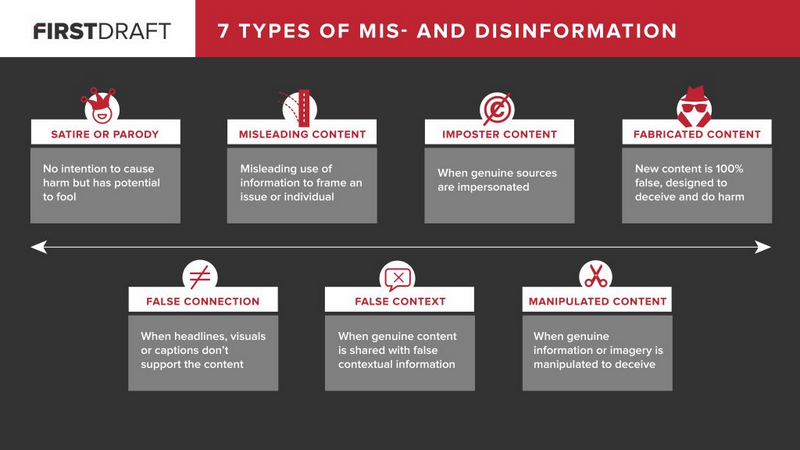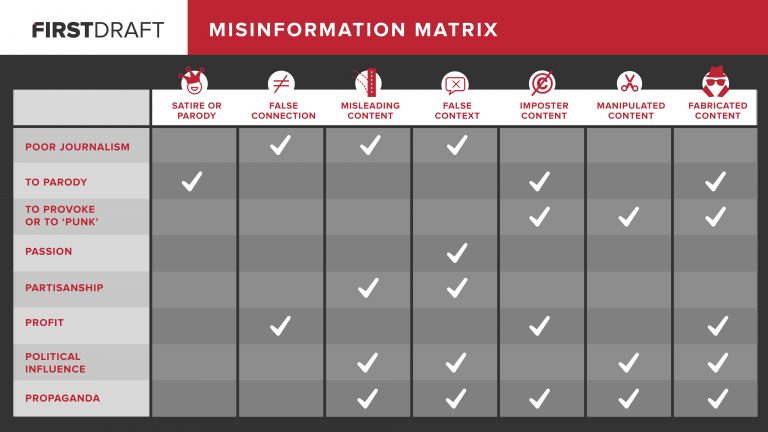SENIORS CLIMATE ACTION NETWORK (SCAN)
Misinformation
The following matrix shows the extent that authors of misinformation with different motivations and intent make use of the above types of misinformation.
There are three basic principles which can be followed to combat misinformation and disinformation.
1. Read widely including information from many points of view.
2. Apply critical thinking.
3. Do not share news articles which you have not read with a critical eye.
A person who practices critical thinking can make an objective and rationale assessment of the assertions and arguments of others. By doing so, a critical thinker is better able to make decisions and solve problems than those who do not practice critical thinking.
Critical thinking involves the ability to recognise the logical form of an argument, deconstruct that argument, and then evaluate the conclusion. Someone with a high IQ and/or who has broad knowledge and a fast memory recall is not necessarily a critical thinker.
Critical thinking includes not only understanding the correct use of logic, but also considers the psychological biases of oneself and others. Critical thinking requires practice, effort, and the humility of being prepared to objectively consider claims and arguments of others which challenge one’s own beliefs.
The process of critical thinking is not intended to make all people think alike and critical thinkers can come to different conclusions due to having a different value system. Actions or inaction which follow beliefs based on some value systems might imperil the rights, wellbeing, and safety of others.
Greg Haskins wrote a 20-page paper “A Practical Guide to Critical Thinking” which was hosted on Skeptic.com beginning in 2004. This paper was largely based on Robert Todd Carroll’s book “Becoming a Critical Thinker - A Guide for the New Millennium” published in 2000. A copy of Haskin’s paper can be downloaded here.
Haskins’ paper divides hindrances to critical thinking into the following four categories:
1. Hindrances due to Basic Human Limitations
2. Hindrances due to Use of Language
3. Hindrances due to Faulty Logic or Perception
4. Hindrances due to Psychological and Sociological Pitfalls
Haskins’ paper forms the basis of his 2016 Kindle book A Practical Guide to Critical Thinking: Essential Steps for Developing Sound Reasoning and Arguments while Overcoming Hindrances to Rational Thinking. This book can be purchased for a nominal sum from Amazon.com. Haskins has added a 5th category "Hindrances due to Natural Biases" in this book.
The following is Haskins’ (2016) description of each category:
Basic Human Limitations
“Basic Human Limitations … applies to everyone, including the most proficient critical thinkers. These limitations remind us that we are not perfect and that our understanding of facts, perceptions, memories, built-in biases, etc., precludes us from ever seeing or understanding the world with total objectivity and clarity. The best we can do is to acquire a sufficient or adequate understanding depending on the issue at hand.”
Use of Language
“The Use of Language… is highly relevant to critical thinking. The choice of words themselves can conceal the truth, mislead, confuse, or deceive us. From ads which guarantee easy weight loss to politicians assuring prosperity for everyone, a critical thinker must learn to recognize when words are not intended to communicate ideas or feelings, but rather to control thought and behavior.”
Faulty Logic or Perception and Psychological and Sociological Pitfalls
“Misconceptions due to Faulty Logic or Perception (Appendix 3) or Psychological and Sociological Pitfalls … can also lead one to erroneous conclusions. A critical thinker must understand how numbers can be used to mislead; perceptions can be misinterpreted due to psychological and sociological influences; and reasoning can be twisted to gain influence and power.”
Natural Biases
“Natural Biases … are hindrances which we develop over time from our own unique cognitive experiences. These experiences cause us to develop our own “rules of thumb” (or heuristic) ways of learning, doing things, approaching problems, and rendering judgments. Though cognitive, these natural biases are heavily influenced by our past emotional experiences.”
Haskin’s paper and book summarise what is required to be a critical thinker. This website would serve no good purpose in providing a summary of a summary. A first step towards becoming a critical thinker is to obtain a copy of Haskin’s paper and/or Kindle book and absorb the contents. Developing critical thinking requires time, effort, and commitment. Further resources on critical thinking can be found on a sister website here.
1. Read widely including information from many points of view.
2. Apply critical thinking.
3. Do not share news articles which you have not read with a critical eye.
A person who practices critical thinking can make an objective and rationale assessment of the assertions and arguments of others. By doing so, a critical thinker is better able to make decisions and solve problems than those who do not practice critical thinking.
Critical thinking involves the ability to recognise the logical form of an argument, deconstruct that argument, and then evaluate the conclusion. Someone with a high IQ and/or who has broad knowledge and a fast memory recall is not necessarily a critical thinker.
Critical thinking includes not only understanding the correct use of logic, but also considers the psychological biases of oneself and others. Critical thinking requires practice, effort, and the humility of being prepared to objectively consider claims and arguments of others which challenge one’s own beliefs.
The process of critical thinking is not intended to make all people think alike and critical thinkers can come to different conclusions due to having a different value system. Actions or inaction which follow beliefs based on some value systems might imperil the rights, wellbeing, and safety of others.
Greg Haskins wrote a 20-page paper “A Practical Guide to Critical Thinking” which was hosted on Skeptic.com beginning in 2004. This paper was largely based on Robert Todd Carroll’s book “Becoming a Critical Thinker - A Guide for the New Millennium” published in 2000. A copy of Haskin’s paper can be downloaded here.
Haskins’ paper divides hindrances to critical thinking into the following four categories:
1. Hindrances due to Basic Human Limitations
2. Hindrances due to Use of Language
3. Hindrances due to Faulty Logic or Perception
4. Hindrances due to Psychological and Sociological Pitfalls
Haskins’ paper forms the basis of his 2016 Kindle book A Practical Guide to Critical Thinking: Essential Steps for Developing Sound Reasoning and Arguments while Overcoming Hindrances to Rational Thinking. This book can be purchased for a nominal sum from Amazon.com. Haskins has added a 5th category "Hindrances due to Natural Biases" in this book.
The following is Haskins’ (2016) description of each category:
Basic Human Limitations
“Basic Human Limitations … applies to everyone, including the most proficient critical thinkers. These limitations remind us that we are not perfect and that our understanding of facts, perceptions, memories, built-in biases, etc., precludes us from ever seeing or understanding the world with total objectivity and clarity. The best we can do is to acquire a sufficient or adequate understanding depending on the issue at hand.”
Use of Language
“The Use of Language… is highly relevant to critical thinking. The choice of words themselves can conceal the truth, mislead, confuse, or deceive us. From ads which guarantee easy weight loss to politicians assuring prosperity for everyone, a critical thinker must learn to recognize when words are not intended to communicate ideas or feelings, but rather to control thought and behavior.”
Faulty Logic or Perception and Psychological and Sociological Pitfalls
“Misconceptions due to Faulty Logic or Perception (Appendix 3) or Psychological and Sociological Pitfalls … can also lead one to erroneous conclusions. A critical thinker must understand how numbers can be used to mislead; perceptions can be misinterpreted due to psychological and sociological influences; and reasoning can be twisted to gain influence and power.”
Natural Biases
“Natural Biases … are hindrances which we develop over time from our own unique cognitive experiences. These experiences cause us to develop our own “rules of thumb” (or heuristic) ways of learning, doing things, approaching problems, and rendering judgments. Though cognitive, these natural biases are heavily influenced by our past emotional experiences.”
Haskin’s paper and book summarise what is required to be a critical thinker. This website would serve no good purpose in providing a summary of a summary. A first step towards becoming a critical thinker is to obtain a copy of Haskin’s paper and/or Kindle book and absorb the contents. Developing critical thinking requires time, effort, and commitment. Further resources on critical thinking can be found on a sister website here.
Misinformation is false or inaccurate information that is mistakenly or inadvertently created or spread; the intent is not to deceive. Disinformation is false information that is deliberately created and spread in order to influence public opinion or obscure the truth. “Fake news” are news stories that are false and these stories are fabricated with no verifiable facts of citations of sources. In recent decades, fake news stories have proliferated via social media, in part because they are so easily and quickly shared online.
According to Claire Wardle of First Draft News, in order to understand and combat mis- and disinformation, we first need to break down the following three elements:
1. The different types of content that are being created and shared.
2. The motivations of those who create this content.
3. The ways this content is being disseminated.
Claire Wardle of has identified 7 types of mis- and disinformation as follows:
According to Claire Wardle of First Draft News, in order to understand and combat mis- and disinformation, we first need to break down the following three elements:
1. The different types of content that are being created and shared.
2. The motivations of those who create this content.
3. The ways this content is being disseminated.
Claire Wardle of has identified 7 types of mis- and disinformation as follows:


